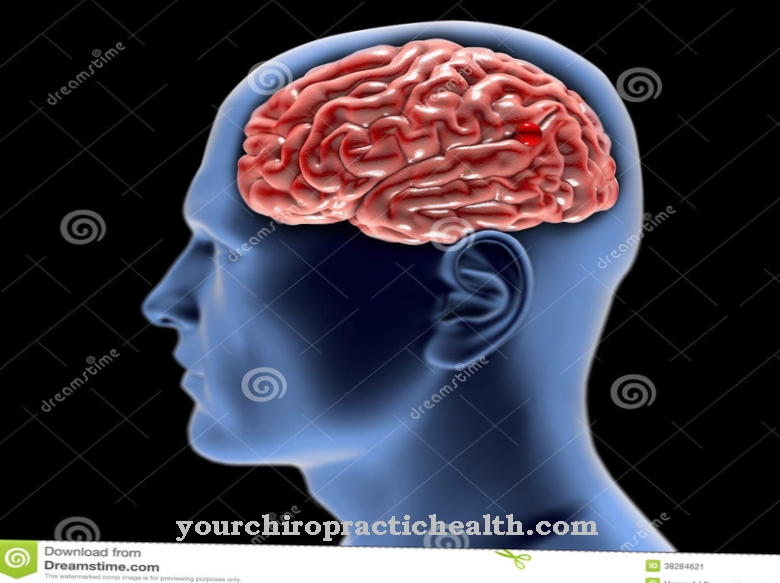As subcortical arteriosclerotic encephalopathy (SAE) is called a brain disease. She is also called Binswanger's disease known.
What is subcortical arteriosclerotic encephalopathy?

© Taleseedum - stock.adobe.com
In the subcortical arteriosclerotic encephalopathy (SAE) is a brain disease caused by changes in blood vessels such as hardening of the arteries (arteriosclerosis). This leads to damage in the subcortical area under the cerebral cortex. The disease also bears the names Multi-infarct dementia, vascular encephalopathy and Binswanger's disease.
Subcortical arteriosclerotic encephalopathy was first described at the end of the 19th century by the psychiatrist and neurologist Otto Ludwig Binswanger (1852-1929) from Switzerland. Subcortical arteriosclerotic encephalopathy is the most common form of vascular dementia. It is one of the encephalopathies and is associated with arterial hypertension. It also results in microangiopathy.
causes
Subcortical arteriosclerotic encephalopathy is caused by arterial hypertension that has been progressing for years and in which the arterioles of the central nervous system (CNS) are permanently damaged by fibrinoid necrosis. This results in tissue destruction. Because the small blood vessels are affected as a result, the affected structures can no longer be properly supplied. This leads to extensive demyelination of the medullary bed.
Furthermore, thromboembolic micro-infarcts occur in the medullary camp, in the ventral brain stem and in the basal ganglia. In earlier years, the demyelination of the marrow camp was the sole reason for the development of dementia symptoms. According to recent research, however, the dementia does not develop at the same time as the marrow damage. Instead, there are neuropathological changes that are Alzheimer's-like. However, it has not yet been possible to determine the exact origin of the disease.
The affected patients often suffer from subcortical arteriosclerotic encephalopathy from diabetes mellitus, arterial hypertension or infarcts in several parts of the brain.
Symptoms, ailments & signs
In its initial stage, subcortical arteriosclerotic encephalopathy takes a gradual course and progresses in stages. Parkinson-like symptoms are considered to be the earliest symptom of SAE. This leads to tremors, immobility and rigidity. In addition, cognitive properties such as concentration, attention and memory are reduced.
However, the old memory is hardly affected by this. On the other hand, new information can only be processed insufficiently. Those affected are therefore hardly able to cope with new situations. However, routine work continues and is meticulously carried out.
In some patients, affective and intellectual flattening occurs after a few years, which is associated with neuropsychological disorders. As subcortical arteriosclerotic encephalopathy progresses, vascular dementia often occurs. Other typical symptoms of SAE are bladder disorders, in which the patient suffers from loss of urine and urinary incontinence, and gait disorders. The latter are characterized by a clumsy, wide-legged and unsteady gait.
In addition, there is a spastic increase in muscle tone. In addition, the patients suffer from subcortical dementia, which leads to a Parkinson's-like loss of drive and slowing down. Paranoia and hallucinations are not uncommon.
Diagnosis & course of disease
The diagnosis of subcortical atherosclerotic encephalopathy can be made with the help of imaging techniques such as computed tomography (CT) or magnetic resonance imaging (MRI). With these methods, extensive demyelination of the medullary bed and lacunar infarcts can be easily recognized. These are shown as whitish foci around the ventricles. The differential diagnosis is also considered important. Similar symptoms can occur in Alzheimer's disease, multi-infarct dementia, multiple sclerosis, HIV encephalopathy, brain edema or radiation damage, among others.
If the subcortical arteriosclerotic encephalopathy changes into vascular dementia, this shortens the life expectancy of the patient. The mortality rate is higher than that of Alzheimer's dementia. It also often leads to serious falls or being bedridden.
Complications
Subcortical arterisclerotic encephalopathy is always associated with severe restrictions on movement. The affected person can walk worse and worse as the disease progresses and eventually becomes immobile. There are also frequent falls and accidents that leave the patient bedridden. The delayed wound healing and the constant lying down can cause secondary symptoms such as edema, circulatory disorders and inflammation.
Prolonged bed rest also worsens cognitive perception and over time causes psychological complaints and changes in personality. Subcortical arterisclerotic encephalopathy can cause bladder disorder. Frequently there is a loss of urine and even incontinence.
Subsequently, the dementia progresses and causes paranoid-hallucinatory symptoms. The life expectancy of the patient is usually reduced. Treatment of the brain disease usually proceeds without major complications. However, the prescribed sedatives may cause severe side effects.
In connection with existing mental illnesses, addictive behavior can also develop. Occupational therapy can cause frustration and anxiety in those affected, as progress is usually made very slowly. Physiotherapy carries the risk of temporary tension or bruises, but is otherwise symptom-free.
When should you go to the doctor?
If the memory impairment persists or gradually increases, there is cause for concern. A doctor should be consulted for control so that the cause can be clarified. Limitations in attention, general memory, and a decrease in mental performance should be investigated. A doctor is needed if the person's resilience decreases, if their personality changes or if abnormal behavior appears. Trembling of the limbs, unsteady gait or disorders of the movement sequences are further signs of a health impairment. A visit to the doctor is necessary so that research into the cause can be initiated.
If the person concerned suffers uncontrolled urine leakage, increasing feelings of shame or shows a withdrawal from social life, action is required. A doctor should be consulted immediately in the event of rigidity or immobility. In severe cases, an ambulance service must be alerted. Hallucinations, listlessness and irregularities in the muscular system are further symptoms of subcortical arteriosclerotic encephalopathy.
You must be presented to a doctor as soon as possible so that medical care can take place. Fatigue, bed rest and persistent exhaustion should be presented to a doctor for examination. Psychological and emotional problems, a decrease in well-being and a general feeling of illness should be discussed with a doctor. If the day-to-day obligations can no longer be carried out independently, the person concerned needs help.
Treatment & Therapy

Furthermore, the extrapyramidal movement disorders, which are a typical feature of SAE, are treated. At the center of the therapy is the compensation of gait disorders, balance disorders and poor coordination. It is important to start treatment as early as possible.
Another pillar of SAE therapy is occupational therapy. It is particularly useful for the treatment of coordination disorders. Furthermore, incontinence counseling and the administration of appropriate agents are provided. The supply of incontinence material helps to make life easier for patients, which also applies to their relatives.
If the patient suffers from restlessness, sedative drugs such as haloperidol, melperone or clomethiazole can be administered to him at night to calm him down. Another important part of treatment is cognitive training. This can also be done jointly by occupational therapists and psychologists.
The aim is to give the patient better orientation as well as more independence and personal responsibility. If there are behavioral disorders, therapists now prefer non-pharmacological interventions. If these treatment measures are not sufficient, the patient is given appropriate medication.
You can find your medication here
➔ Medicines against memory disorders and forgetfulnessprevention
Since the causes of subcortical arteriosclerotic encephalopathy are largely unknown, targeted prevention is hardly possible. There are also no drugs that can prevent or at least delay SAE or vascular dementia. Certain preparations are offered, but their harm is usually greater than their benefit.
Aftercare
The SAE cannot be completely cured. The progression of the disease can only be influenced slightly by the administration of medication. Due to its chronic nature, accompanying follow-up care is useful. A largely normal life is the goal of follow-up therapy approaches. The patient's quality of life should be stabilized and his independence should be maintained for as long as possible.
In the case of subcortical arteriosclerotic encephalopathy, follow-up care is physiotherapeutic and psychotherapeutic. Simultaneous care by a neurologist is also advisable. The mobility of the patient should be improved through physiotherapeutic exercises. Existing vascular diseases require medical treatment. This reduces the risk for an SAE. When using medication, a specialist must check whether it is tolerated.
Side effects must be recognized and treated early on. Follow-up care also affects relatives. You will receive advice from the therapist on how to deal with the patient on a daily basis. Those affected have the option to take preventive measures themselves: a healthy lifestyle can reduce the likelihood of SAE. A varied diet and avoiding nicotine or alcohol are beneficial. A change in diet, however, is part of the aftercare. The patient should refrain from cigarettes or too much alcohol after receiving the diagnosis.
You can do that yourself
Once the disease is diagnosed, therapies can only relieve symptoms and slow the progression of the disease. To do this, patients must carefully adhere to the therapy plans of their treating physicians, take the prescribed medication regularly and keep their physiotherapy appointments. It is possible that keeping appointments is difficult due to the reduced short-term memory, which is why patients often need help and care at an early stage.
Visiting a psychologist or psychiatrist can also help. On the one hand, to cope with the stressful illness situation, on the other hand, to take part in cognitive training that is intended to prevent or slow down further memory loss. Family members may also benefit from accompanying psychotherapy, since caring for a person with subcortical arteriosclerotic encephalopathy can be very stressful.
The high blood pressure that may be the underlying cause of the disease must definitely be reduced permanently and continuously in order to avoid further damage. This means that the patient can still do a few things himself in addition to the corresponding medication to improve his situation. This includes, for example, abstaining from alcohol and nicotine. Nicotine in particular closes the blood vessels and thereby aggravates the subcortical arteriosclerotic encephalopathy. The intake of omega-3 fatty acids, however, is advisable. There are fish oil capsules on the market that contain these fatty acids, but linseed oil is also a good source of omega-3 fatty acids.


.jpg)

.jpg)






















